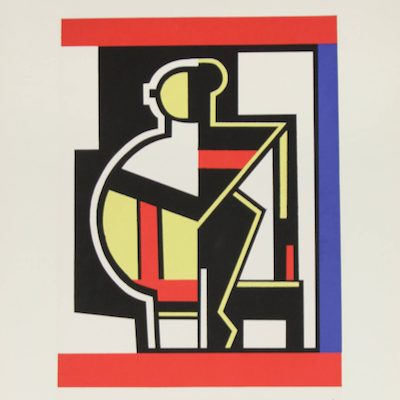
Details
Artist
Styles
Etching and aquatint in colours, on BFK Rives paper, with full margins. - This work is from the UNITÉ book, which began to be printed in 1963 and ended on October 15, 1965 in Paris. - I. 41.5 x 31.5 cm (16 3/8 x 12 3/8 in.) - S. 57 x 45.2 cm (22 1/2 x 17 3/4 in.) - Signed, dated and numbered in pencil, from the edition of 130 pc + 30 in Roman numerals, published by Atelier Crommelynck, Paris // Le Corbusier’s Unité 1 (1963-1965) is a limited-edition etching and aquatint in colors, printed on BFK Rives paper. The composition depicts a reclining figure with exaggerated, abstracted forms outlined in bold black lines. The figure's torso features large blue and red shapes, with the blue suggesting volume and the red adding contrast. The use of curvilinear shapes and minimalistic details evokes a sense of both rest and tension. The brown background is subdued, allowing the vibrant colors of the body to stand out. This piece reflects Le Corbusier's exploration of the human form in relation to space, merging organic and geometric elements in a way that suggests both abstraction and figuration.
Unité 1, 1963-1965
form
Medium
Size
45.2 x 57 cm
- Inches
- Centimeters
Edition
Price
- USD
- EUR
- GBP
Details
Artist
Styles
Etching and aquatint in colours, on BFK Rives paper, with full margins. - This work is from the UNITÉ book, which began to be printed in 1963 and ended on October 15, 1965 in Paris. - I. 41.5 x 31.5 cm (16 3/8 x 12 3/8 in.) - S. 57 x 45.2 cm (22 1/2 x 17 3/4 in.) - Signed, dated and numbered in pencil, from the edition of 130 pc + 30 in Roman numerals, published by Atelier Crommelynck, Paris // Le Corbusier’s Unité 1 (1963-1965) is a limited-edition etching and aquatint in colors, printed on BFK Rives paper. The composition depicts a reclining figure with exaggerated, abstracted forms outlined in bold black lines. The figure's torso features large blue and red shapes, with the blue suggesting volume and the red adding contrast. The use of curvilinear shapes and minimalistic details evokes a sense of both rest and tension. The brown background is subdued, allowing the vibrant colors of the body to stand out. This piece reflects Le Corbusier's exploration of the human form in relation to space, merging organic and geometric elements in a way that suggests both abstraction and figuration.
- Recently Added
- Price (low-high )
- Price (high-low )
- Year (low-high )
- Year (high-low )
What is Cubism?
Cubism is an art movement that aimed to depict multiple perspectives of objects or figures within a single picture. Artists Georges Braque and Pablo Picasso pioneered this style around 1907. The name Cubism emerged from their use of geometric shapes and outlines that often resembled cubes, breaking objects down into abstracted forms.


























